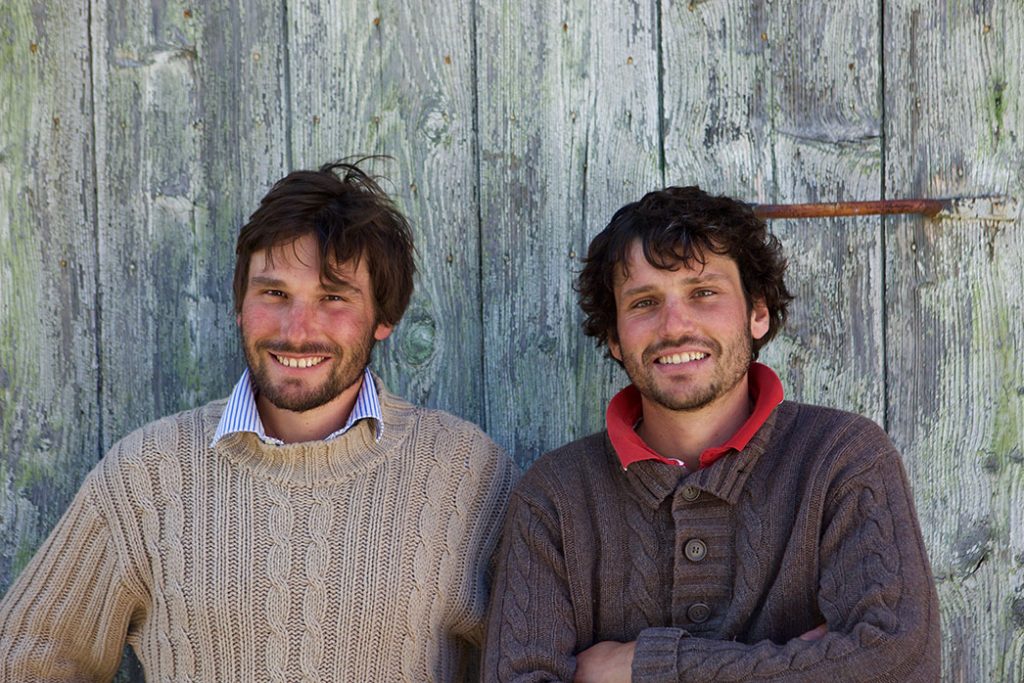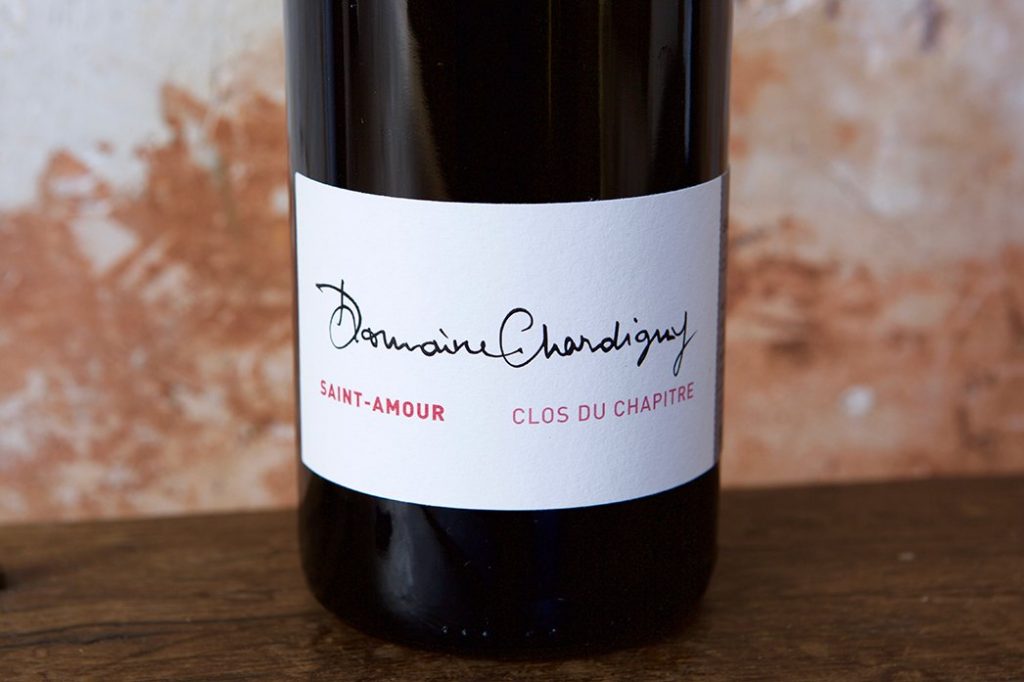
After leaving Chez Dutraive, our next stop was a business call to two promising young Beaujolais producers that Jean-Louis had met a few months earlier, when they had sold him a shipment of much-needed grapes after the losses to hail. Once he tasted their wines it immediately occurred to him that Ted should meet them.
Again we drove through countryside usually only seen in photographs: one-lane roads squeezed between verdant berms among huge expanses of now green and healthy vineyards stretching to a distant horizon, under blue skies mottled with perfectly spaced cotton ball clouds. There were actual castles on distant hilltops, just for good measure. Ancient crumbling walls and structures lined the road and lay in piles in the fields. I kept wanting to reach for my camera, but it occurred to me that if I did this every time I thought of it, I’d never put it down.
New research suggests that the practice of always holding a camera in front of an experience greatly diminishes our ability to retain what we are seeing; somehow by concentrating on storing images in a device, they are less likely to store in our brains. Then we have thousands of photos we often don’t look at again later on, and the bulk of what we’ve seen is forgotten. I kept my phone in my pocket as much as I could and recorded everything with my eyeballs.
We were yet again sent sideways by the white wagon’s navigation system, and by late afternoon finally found the domaine of brothers Victor Emmanuel and Pierre-Maxime Chardigny. Both were boyishly handsome and surprisingly young; Victor was in his early twenties, while Pierre-Maxime was just short of thirty. They were both a little shy and quietly earnest at first. They showed us the buildings they had recently acquired for their operation: what appeared to be big barns, a bit ramshackle and in need of renovation, but full of promise. Then they took us around back to a large expanse of their parcels as a chilly wind kicked up that sent me running back to the car for my coat. The guys gave us the rundown in threadbare cable knit sweaters, seemingly immune to the cold.

They told us that when they were growing up, their father had a mobile bottling machine, so they got to know a lot of winemakers in the area. Eventually he was able to buy some land that he rented out to a vigneron who worked the land for a few decades. When the maker retired, the land returned to the family and Victor and Pierre-Maxime jumped at the chance to take over and start their own operation.
While Victor is the resident maker and holds a National Diploma in Enology, Pierre-Maxime runs the business side of things. They also have a third brother who has a degree in agronomy and works for the famed biodynamically run Domaine Leflaive, so he contributes with advice on crop production and soil management.

At the time of our visit, they had twelve hectares, and their cousin contributed to their efforts with an additional eight. All of the vines were surrounded by healthy green undergrowth; in recent years the land had been chemically farmed, but they had plans to go completely organic and biodynamic and were looking to achieve full certification in 2018.
They pointed at some slopes in the distance where they had more vines and said they had yet another on the other side of the hill. Then they jumped in their little white Toyota Tercel and took us over to each parcel, where Ted and Andrea clicked away with their cameras and Ted rubbed stone and dirt between his fingertips. At our third stop, their vineyards overlooked a small valley with a church and graveyard surrounded by more vineyards. I wondered aloud if the graves would have any effect on the grapes around them and Victor gave me a wry smile and a shrug.
Their primary production facility was in another big barn beside a house to which they would expand in the coming year, though there was the possible complication with an old lady who had lived in the top floor for decades. Inside the big rickety doors with peeling pain and an ancient lock, the space was filled with a tight crowd of steel tanks that on first glance looked like a mob of hulking robots from an old sci-fi movie. Through another door to the side was a small room with new oak barrels stacked in triangles of three. Victor poured tastes from his pipette and he and his brother spoke with humility, gratitude and pride about the growing success of their new enterprise. As we tasted, Ted continued to be surprised by the quality of the work coming from such a young vigneron.
We got into our cars again and followed them to a large house with a tall iron gate. Inside on the property was a sprawling lawn full of trees with big white blooms called boule de neige (snowball), a type of rhododendron. Across from their father’s huge limestone house, there was another building filled with more tanks and equipment, shiny and fresh out of the box, which they had recently purchased to keep up with their rapid expansion. Under the beautiful home, which was draped with big clusters of pale purple wisteria that Pierre Maxim referred to as glycine, there was a tidy tasting room with stone walls and a low wooden ceiling. We all sat around an antique oak table, as Victor Emmanuel opened bottles and poured the newest cuvées.
Ted mentioned that he was one of three brothers as well, separated by about the same number of years as the Chardignys. He immediately pegged these guys as having a similar dynamic to his with his older brother; there was even a little tension caused by Pierre-Maxime being more assertive and bossy, while Victor had a mischievous glint in his eye. Pierre-Maxime said Victor is prone to jokes and pranks, like Ted has always been. A big difference was that Ted’s brothers aren’t involved in his business, but his sister Victoria is the general manager of his office and developed the entire administration side of things almost from scratch.
Ted was enjoying the wines immensely and was already sure he wanted to do business with them, a decision compounded by this newfound sense of kinship. They were being distributed to some extent across Europe, but seemed to be hesitant about going overseas, or maybe even starting with someone new in any capacity. They had recently been burned by a middleman who had taken a huge shipment of bottles and then disappeared and never paid them. Ted assured them that his reputation for scrupulousness was sound, as Dutraive, for one, could attest. They quickly conceded the point as Ted said he would see that they benefit greatly from being distributed widely in his territories of Chicago, California and Oregon, all of which he would soon be expanding.


Ted continued: “I like to support producers in any way I can. I don’t consider myself a merchant, more a partner. The lines of communication are always open; I want everyone to feel free to communicate their questions and needs at all times.” The Chardignys were soon as sold as Ted was.
Ted mentioned that we had been at Julien Zernott’s place the day before, and Pierre-Maxime said they had exchanged bottles with him a few months earlier. Zernott had left six for them at Dutrave’s and when Pierre-Maxime heard that he would be at Dutraive’s again more recently, they brought him six bottles in return and got to meet him. Ted and the guys talked about the regular practice of vignerons exchanging their wares, the meeting of peers and gaining of friends in the process.
Ted started in on talking allotments and noticed that the stack of boxes against the wall were all in six packs, their preferred way of doing things thus far. He said it would be helpful for them to upgrade to boxes of twelve, since the shipping companies charge per box, not just weight. That change alone would clearly reduce transport costs by half. Pierre-Maxime expressed surprise at this, but it was just one of many things he would be learning as he took the jump across the Pacific.
Back outside, talk turned to the personal again, as Pierre-Maxime said that he was relocating to Lyon to move in with his longtime girlfriend, a physics student. I was surveying the beautiful grounds and the rolling land of Burgundy beyond, when I asked about the house. He said it has been in the family for three hundred years and the big lawn out back was often used for parties. It seemed to me like it would be the perfect place to get married (if one was into that sort of thing).


